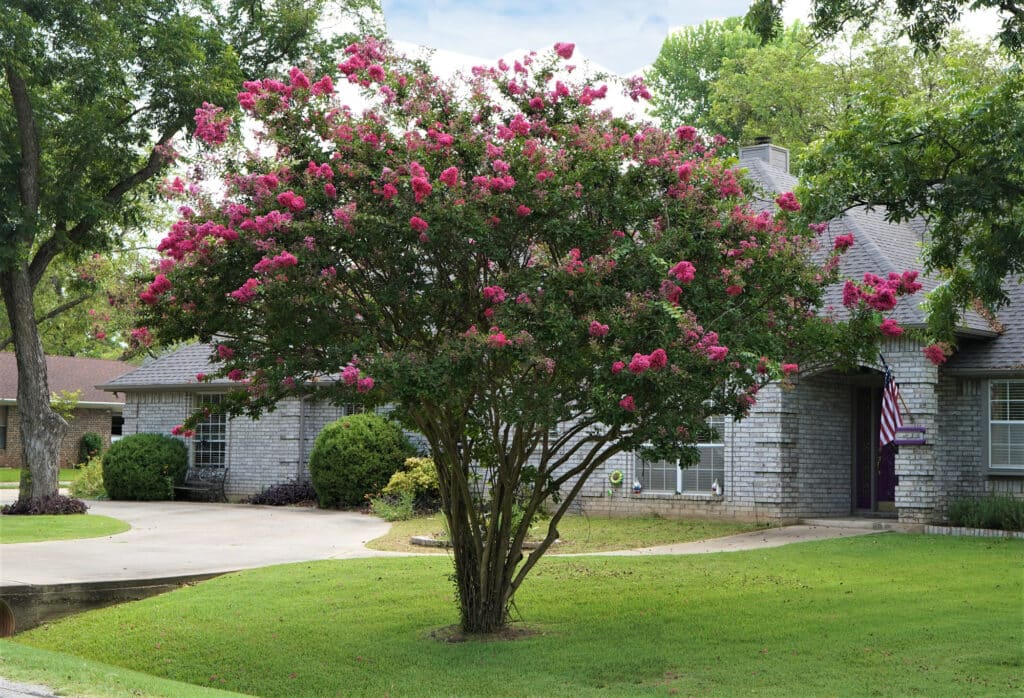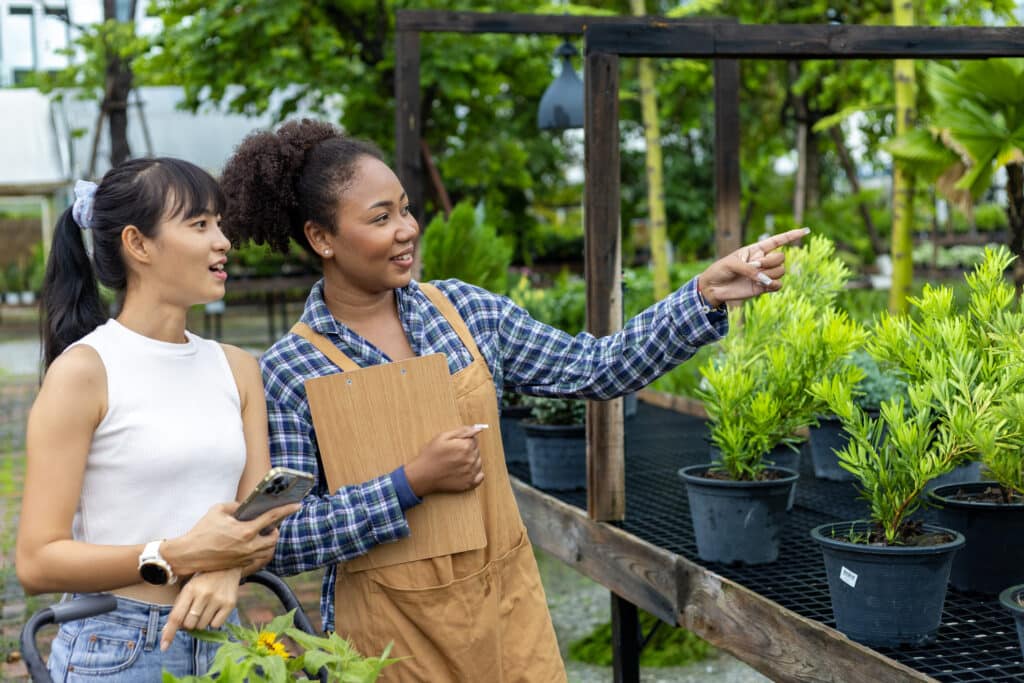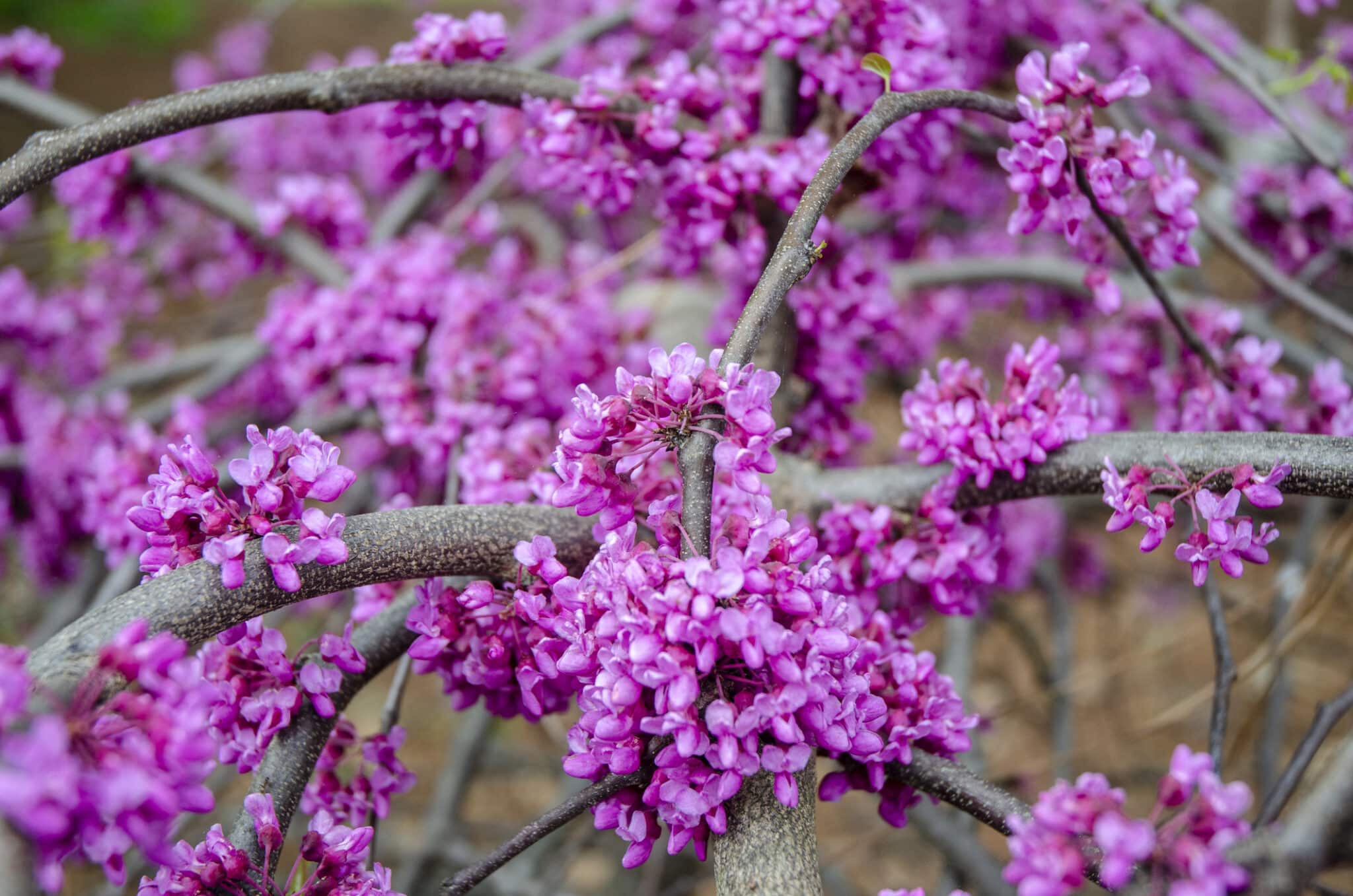Top Ornamental Trees for Dallas
For Dallas landscapes, top ornamental trees include the vibrant Crape Myrtle and early-blooming Texas Redbud. The Desert Willow thrives in heat with its exotic flowers, while the Mexican Plum offers fragrant spring blossoms and fruit. The Southern Magnolia adds elegance with large blooms and evergreen foliage. For shade, the Chinquapin Oak provides seasonal beauty, and the Eastern Red Cedar is perfect for privacy. The Yaupon Holly adds bright red berries in winter. These trees thrive in Dallas’ climate and bring beauty to any yard while requiring minimal maintenance.

Are you looking to add a touch of beauty and elegance to your Dallas yard? Ornamental trees could be the perfect solution! These trees are known for their stunning flowers, unique shapes, and vibrant foliage that can transform any landscape into a work of art.
But with Dallas’ unique climate and soil, choosing the right tree can be tricky. In this guide, we’ll explore the best ornamental trees for Dallas, and give you tips on how to care for them so your yard can truly shine.
Understanding the Importance of Ornamental Trees
What Makes a Tree Ornamental?
Ornamental trees are specifically selected for their beauty. This can come from vibrant flowers, unique leaves, striking bark, or even a dramatic shape.
Unlike larger shade trees, which primarily provide cover from the sun, ornamental trees are all about adding character and style to your garden.
They’re the trees you plant to make your yard stand out and to create focal points that draw the eye.
The Role of Ornamental Trees in Dallas Landscapes
In Dallas, where the climate can be quite challenging, ornamental trees are a perfect choice for adding beauty to your landscape without overwhelming your space.
These trees are often more adaptable to the local conditions, meaning they can thrive with less water and care compared to other types of trees. Plus, they can provide a touch of nature’s artistry in a city where concrete and buildings dominate the scenery.
Imagine a gorgeous Crape Myrtle lighting up your yard with its summer blooms or a Texas Redbud adding a splash of color in early spring.
Climate and Soil Conditions in Dallas
Understanding Dallas’ Climate
Dallas is known for its hot, humid summers and mild winters. With temperatures often soaring above 90°F in the summer, choosing trees that can withstand the heat is crucial.
Additionally, Dallas experiences occasional droughts, so drought tolerance is another important factor to consider. However, the city also gets its fair share of rain, especially in the spring and fall, which can be a blessing for your trees if you’ve chosen the right ones.
Best Soil Types for Ornamental Trees in Dallas
The soil in Dallas can vary widely, but it often leans towards heavy clay, which can be challenging for some trees. Clay soil holds water well but can become compacted, making it hard for roots to breathe.
The good news is that many ornamental trees are adaptable to a variety of soil types, including clay. If your yard has particularly tough soil, you might need to amend it with organic matter to improve drainage and root growth.
Top Ornamental Trees Suitable for Dallas
Crape Myrtle (Lagerstroemia)
Crape Myrtles are a favorite in Dallas for a reason. These trees are known for their long-lasting summer blooms, which come in a variety of colors like pink, red, purple, and white.
They add vibrant color to landscapes from late spring to early fall, making them a focal point in any garden. They’re also incredibly hardy, handling the Dallas heat and drought conditions with ease. Plus, their beautiful peeling bark adds winter interest when the flowers are gone, ensuring year-round appeal.
Texas Redbud (Cercis canadensis var. texensis)
The Texas Redbud is another fantastic choice, especially if you want early spring color. These trees burst into bloom with bright pink or purple flowers before the leaves even appear, making them a standout in any garden.
The Texas Redbud is particularly well-suited to Dallas, as it’s highly adaptable to the local soil and climate conditions.
Its heart-shaped leaves add a soft texture to the landscape, and its compact size makes it perfect for smaller yards. It’s a low-maintenance tree that brings a lot of beauty to the landscape with minimal effort.
Desert Willow (Chilopsis linearis)
If you’re looking for something a bit more unique, the Desert Willow is a great pick. With its slender, willow-like leaves and trumpet-shaped flowers that bloom from spring through fall, this tree adds a touch of the exotic to your yard.
It’s incredibly drought-tolerant, thriving in the hot, dry summers that are typical in Dallas. The Desert Willow is also resistant to most pests and diseases, making it a low-maintenance choice. Its graceful, airy structure and long blooming season make it a standout feature in any landscape.
Mexican Plum (Prunus mexicana)
The Mexican Plum is perfect for those who love the idea of a flowering tree that also produces fruit. In early spring, this tree is covered in fragrant white blossoms that attract pollinators like bees and butterflies.
By late summer, it bears small, sweet plums that you can enjoy fresh or use in homemade jams and preserves.
This tree is also highly adaptable, thriving in a variety of soil types and requiring minimal care once established. Its compact size makes it suitable for smaller yards or as a beautiful accent in larger landscapes.
Southern Magnolia (Magnolia grandiflora)
For a touch of Southern charm, the Southern Magnolia is a must. This tree is known for its large, glossy leaves and huge, fragrant white flowers that bloom throughout the summer.
The Southern Magnolia is a true showstopper, providing a stately presence in any landscape. It’s an evergreen, meaning it retains its beautiful foliage year-round, providing consistent color and texture even in the winter.
While it can get quite large, it’s a beautiful focal point for bigger yards and provides a wonderful, fragrant canopy.
Chinquapin Oak (Quercus muehlenbergii)
The Chinquapin Oak is a versatile tree that offers both ornamental beauty and the strength of an oak. Its leaves are an attractive dark green in the summer and turn a beautiful yellow-brown in the fall, providing seasonal interest.
This tree is well-suited to the clay soils often found in Dallas, making it a sturdy and reliable choice for local landscapes.
The Chinquapin Oak also provides excellent shade, which can help keep your yard cooler during the hot summer months. Its strong, durable wood and long lifespan make it a valuable addition to any landscape.
Eastern Red Cedar (Juniperus virginiana)
Eastern Red Cedars are tough, evergreen trees that can handle just about anything Dallas throws at them. Their dense foliage provides year-round privacy and wind protection, making them a practical choice for boundary planting.
These trees are highly adaptable, thriving in poor soil conditions and withstanding drought, making them low-maintenance. The berries produced by Eastern Red Cedars attract birds, adding another layer of life to your garden.
Their tall, slender shape makes them ideal for use as screens or windbreaks, and they can also be shaped into topiaries for added visual interest.
Yaupon Holly (Ilex vomitoria)
Finally, the Yaupon Holly is a smaller tree, but it packs a punch in terms of visual interest. This evergreen tree produces bright red berries in the fall and winter, adding a pop of color when most other trees are bare.
Its dense foliage makes it ideal for privacy hedges or as an accent tree in the landscape. Yaupon Holly is highly adaptable, thriving in both sun and shade and tolerating a range of soil conditions, including the heavy clay common in Dallas.
It’s also resistant to drought, pests, and diseases, making it a low-maintenance option that offers year-round beauty.

Tips for Selecting the Right Ornamental Tree for Your Landscape
Choosing the right ornamental tree for your Dallas landscape can be a bit overwhelming, given the variety of beautiful options available.
However, with a few key considerations in mind, you can select the perfect tree that meets both your aesthetic goals and practical needs.
Let’s explore some tips to help you make the best choice for your yard and ensure that your new tree will thrive for years to come.
Assessing Your Yard’s Conditions
Before selecting a tree, it’s important to take a good look at your yard’s conditions. This step is crucial because different trees have different requirements, and matching those needs to what your yard offers will set your tree up for success. Here are some key points to assess:
- Sunlight: Determine if your yard gets full sun, partial shade, or a mix of both. Full-sun areas are ideal for sun-loving trees like the Crape Myrtle, while partial shade may be better suited for a Texas Redbud.
- Soil Type: Identify whether your soil is sandy, loamy, or heavy clay. Some trees are more adaptable, while others might need specific soil amendments to thrive. For example, Southern Magnolias do well in well-draining soil, while Desert Willows are more tolerant of poorer, drier conditions.
- Space: Consider the amount of space available for the tree to grow. Some trees, like the Chinquapin Oak, can grow quite large and need plenty of room, while others, like the Yaupon Holly, are better for smaller spaces or as accent trees.
Understanding these conditions will help you narrow down your options to trees that will thrive in your specific environment, ensuring that your investment pays off in a beautiful, healthy landscape.
Matching Trees to Your Aesthetic Goals
When selecting an ornamental tree, think about what kind of visual impact you want to achieve in your landscape.
The right tree can serve as a stunning focal point or complement other elements in your garden. Consider the following aspects to match your tree choice with your aesthetic goals:
- Color: For those wanting to add a splash of vibrant color, Crape Myrtles deliver showy blooms in various shades, perfect for creating a lively atmosphere.
- Texture: Some trees have smooth, glossy leaves, like the Southern Magnolia, while others offer a more rugged or delicate texture. The texture can add depth and interest to your landscape.
- Size: Consider the mature size of the tree to ensure it fits well in your yard’s layout. Larger trees like the Chinquapin Oak can create a grand, stately presence, while smaller trees like the Mexican Plum offer beauty without overwhelming the space.
By carefully considering these elements, you can choose a tree that not only thrives in your yard but also enhances the overall look and feel of your landscape.
Balancing Maintenance Requirements
While all trees require some care, the maintenance level can vary significantly depending on the species.
It’s important to consider how much time and effort you’re willing to invest in maintaining your tree. Here are a few factors to keep in mind when evaluating maintenance needs:
- Watering: Trees like the Desert Willow are drought-tolerant and need minimal watering, making them ideal for low-maintenance landscapes in Dallas’ hot, dry summers. On the other hand, trees like the Southern Magnolia might require more regular watering, especially during dry spells.
- Pruning: Regular pruning is essential for some trees to maintain their shape and promote healthy growth. For example, the Crape Myrtle benefits from seasonal pruning to encourage more blooms, while the Eastern Red Cedar generally requires little pruning.
- Pest Resistance: Choose trees that are resistant to common pests in the Dallas area to reduce the need for chemical treatments. Trees like the Texas Redbud are naturally resistant to many pests and diseases, making them easier to care for.
If you prefer a more hands-off approach, opt for trees known for their resilience and low upkeep needs. This will ensure that your landscape remains beautiful without requiring constant attention, allowing you to enjoy your garden rather than work on it constantly.
How to Plant and Care for Ornamental Trees in Dallas
Once you’ve selected the perfect ornamental trees for your Dallas landscape, the next step is ensuring they thrive through proper planting and tree care.
These trees, while hardy, need the right conditions to flourish in the unique Dallas climate. Here’s how to plant and maintain your ornamental trees for long-term health and beauty.
Planting Tips for Success
The best time to plant ornamental trees in Dallas is during the cooler months of fall or early spring. This timing allows the roots to establish before the summer heat arrives.
When planting, dig a hole twice as wide as the root ball but no deeper, and amend heavy clay soil with organic matter to improve drainage. Position the tree so the top of the root ball is level with the soil surface to prevent waterlogging.
Watering and Mulching Best Practices
Watering is crucial for newly planted ornamental trees, especially in their first year. Deep, consistent watering helps establish strong roots, with frequency decreasing as the tree matures.
Mulch around the base of the tree to retain moisture, regulate temperature, and reduce weed competition, but avoid piling mulch against the trunk to prevent rot. A mulch ring extending to the drip line is ideal for protecting roots and enhancing tree health.
Pruning and Seasonal Care
Pruning is essential for maintaining the health and shape of your ornamental trees. The best time to prune is late winter or early spring before new growth begins, allowing you to shape the tree and remove any dead or diseased branches.
For flowering trees, time your pruning based on their blooming season to avoid cutting off future blossoms. Regular seasonal care, including monitoring for pests and adjusting watering, ensures your trees remain vibrant and healthy year-round.
Transform Your Dallas Yard with Expert Tree Care
Ready to enhance your Dallas landscape with stunning ornamental trees? At S&P Tree Service, we specialize in helping you choose and care for the perfect trees that thrive in our local climate.
Whether you’re looking to add color, shade, or structure, our team has the expertise to make your vision a reality. Contact us today to start creating the yard of your dreams!

FAQs
What Ornamental Tree Grows the Fastest in Dallas?
The Crape Myrtle is one of the fastest-growing ornamental trees in Dallas. Known for its rapid growth and vibrant blooms, it can quickly become a standout in your landscape. With proper care, it can grow several feet each year, providing both shade and beauty.
How Do I Choose Between Flowering and Non-Flowering Ornamental Trees?
Choosing between flowering and non-flowering ornamental trees depends on your aesthetic goals. Flowering trees like the Texas Redbud add seasonal color, while non-flowering trees like the Eastern Red Cedar offer consistent greenery year-round. Consider how you want your landscape to look throughout the year to make the best choice.
Can These Ornamental Trees Withstand Dallas Heat and Drought?
Yes, many ornamental trees suitable for Dallas are chosen for their ability to handle heat and drought. Trees like the Desert Willow are particularly resilient, thriving in the hot, dry summers typical of Dallas. Proper planting and care will further enhance their ability to withstand tough conditions.
What Are the Best Ornamental Trees for Small Yards in Dallas?
For smaller yards, compact ornamental trees like the Yaupon Holly and Mexican Plum are excellent choices. These trees provide beauty without taking up too much space, making them perfect for smaller landscapes. Their manageable size also makes them easier to maintain.
How Can I Ensure My Ornamental Trees Stay Healthy Year-Round?
To keep your ornamental trees healthy year-round, focus on regular maintenance. This includes proper watering, mulching, and timely pruning to encourage growth and prevent disease. Monitoring for pests and addressing issues early will also help keep your trees in top condition.


